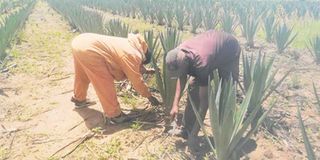Villagers benefit from sisal farming

Farmers work at a sisal farm in Kishapu District, Shinyanga Region. PHOTO | gadiosa lamtey
What you need to know:
- The Tanzania Sisal Board shows that 37,255.30 tonnes of sisal were produced last year, 7,750.84 tonnes of them being in the Lake Zone
Kishapu. Farmers in Kishapu District, Shinyanga Region, are benefiting from sisal farming.
Sisal is one of Tanzania’s traditional strategic crops and the residents have started to grow it as cotton and many other cash crops have failed.
The farmers discovered that sisal can well grow, thanks to Oxfam Tanzania and Relief to Development Society (Redeso) which provided knowledge on the crop potential and value addition.
The Tanzania Sisal Board shows that 37,255.30 tonnes of sisal were produced last year.
Of the amount, 7,750.84 tonnes were produced in the Lake Zone in which Kishapu is located.
Farmers in Kishapu and Meatu where Oxfam implements the project of sisal value chain have cut poverty.
A Mwaisengela Village farmer in Meatu District said he started growing sisal in 2014 after receiving training from Oxfam.
“Before, I used to cultivate maize and cotton and keep livestock,” he said. “In fact every year I didn’t get enough food. So life was difficult. However, since I started growing sisal I have built two houses.”
He has his own processing machine and provides temporary jobs.
Unlike maize and cotton, sisal is drought-resistant.
It does not require fertilisers or pesticides like coffee, cashew nuts and cotton.
Since Kishapu is semi-arid, the residents sometimes face food shortages. Sisal matures in four or five years and a farmer can harvest it for almost ten years.
Kishapu has 345,000 people, according to acting district executive director George Jessi. Ninety per cent of householders depend on agriculture.
The Oxfam project has encouraged farmers to grow and process sisal.
Sisal cultivation has spread to Meatu in Simiyu Region.
Currently more than 1,570 residents in Kishapu grow it. Others cultivate and process it.
Redeso field officer Erica Karutha said the project started in 2000. For almost 12 years, farmers were trained on how to plant, harvest and process it.
She said also Oxfam gave processing machines on credit.
Farmers also got improved seeds from Tanga. “One of the project targets was to empower women who most of the time take care of families,” she said.
Oxfam Tanzania communications manager Kisuma Mapunda said the organisation was empowering farmers in Geita, Shinyanga and Simiyu.
Ms Karutha said 150 groups had been formed. Out of them 100 are women groups while remaining have both men and women.
Some women groups make sisal fibre products for sale.
Through sisal business, residents launched a Sacoss in 2014 with Sh50 million in shares.
Some farmers have established a group to clean sisal fibres.
Redeso has submitted a sample to the Sokoine University of Agriculture for testing if the sisal waste can be used as a feed for livestock.




